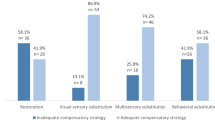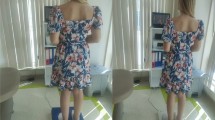Abstract
Purpose
Patients with acute peripheral unilateral hypofunction (UVH) complain of vertigo and dizziness and show posture imbalance and gaze instability. Vestibular rehabilitation therapy (VR) enhances the functional recovery and it has been shown that gaze stabilization exercises improved the dynamic visual acuity (DVA). Whether the effects of VR depend or not on the moment when it is applied remains however unknown, and investigation on how the recovery mechanisms could depend or not on the timing of VR has not yet been tested.
Methods
Our study investigated the recovery of DVA in 28 UVH patients whose unilateral deficit was attested by clinical history and video head impulse test (vHIT). Patients were tested under passive conditions before (pre-tests) and after (post-tests) being subjected to an active DVA rehabilitation protocol. The DVA protocol consisted in active gaze stabilization exercises with two training sessions per week, each lasting 30 min, during four weeks. Patients were sub-divided into three groups depending on the time delay between onset of acute UVH and beginning of VR. The early DVA group (N = 10) was composed of patients receiving the DVA protocol during the first 2 weeks after onset (mean = 8.9 days), the late group 1 (N = 9) between the 3rd and the 4th week (mean = 27.5 days after) and the late group 2 (N = 9) after the 1st month (mean: 82.5 days). We evaluated the DVA score, the angular aVOR gain, the directional preponderance and the percentage of compensatory saccades during the HIT, and the subjective perception of dizziness with the Dizziness Handicap Inventory (DHI). The pre- and post-VR tests were performed with passive head rotations done by the physiotherapist in the plane of the horizontal and vertical canals.
Results
The results showed that patients submitted to an early DVA rehab improved significantly their DVA score by increasing their passive aVOR gain and decreasing the percentage of compensatory saccades, while the late 1 and late 2 DVA groups 1 and 2 showed less DVA improvement and an inverse pattern, with no change in the aVOR gain and an increase in the percentage of compensatory saccades. All groups of patients exhibited significant reductions of the DHI score, with higher improvement in subjective perception of dizziness handicap in the patients receiving the DVA rehab protocol in the first month.
Conclusion
Our data provide the first demonstration in UVH patients that earlier is better to improve DVA and passive aVOR gain. Gaze stabilization exercises would benefit from the plastic events occurring in brain structures during a sensitive period or opportunity time window to elaborate optimal functional reorganizations. This result is potentially very important for the VR programs to restore the aVOR gain instead of recruiting compensatory saccades assisting gaze stability.





Similar content being viewed by others
References
Herdman SJ, Tusa RJ, Blatt PJ, Suzuki A, Venuto PJ, Roberts D (1998) Computerized dynamic visual acuity test in the assessment of vestibular deficits. Am J Otol 19:790–796
Dieringer N (1988) Immediate saccadic substitution for deficits in dynamic vestibular reflexes of frogs with selective peripheral lesions. Prog Brain Res 76:403–409
Berthoz A (1988) The role of gaze in compensation of vestibular disfunction: the gaze substitution hypothesis. Prog Brain Res 76:411–420. https://doi.org/10.1016/S0079-6123(08)64528-8
Schubert MC, Migliaccio AA, Clendaniel RA, Allak A, Carey JP (2008) Mechanisms of dynamic visual acuity recovery with vestibular rehabilitation. Arch Phys Med Rehabil 89:500–507. https://doi.org/10.1016/j.apmr.2007.11.010
Kazai T, Zee DS (1978) Eye-head coordination in labyrinthine-defective human beings. Brain Res 144:123–141. https://doi.org/10.1016/0006-8993(78)90439-0
Schubert MC, Das V, Tusa RJ, Herdman SJ (2004) Cervico-ocular reflex in normal subjects and patients with unilateral vestibular hypofunction. Otol Neurotol 25:65–71
Bockisch CJ, Straumann D, Hess K, Haslwanter T (2004) Enhanced smooth pursuit eye movements in patients with bilateral vestibular deficits. NeuroReport 15:2617–2620
Gauthier GM, Robinson DM (1975) Adaptation of the human vestibulo-ocular reflex to magnifying lenses. Brain Res 92:331–335
Schubert MC, Della Santina CC, Shelhamer M (2008) Incremental angular vestibulo-ocular adaptation to active head rotation. Exp Brain Res 191:435–446
Migliaccio AA, Schubert MC (2013) Unilateral adaptation of the human angular vestibulo-ocular reflex. J Assoc Res Otol 14:29–36. https://doi.org/10.1007/s10162-012-0359-7
Migliaccio AA, Schubert MC (2014) Pilot study of a new rehabilitation tool: improved unilateral short-term adaptation of the human angular vestibulo-ocular reflex. Otol Neurotol 35:310–316. https://doi.org/10.1097/MAO.00000000000000539
Crane BT, Schubert MC (2018) An adaptive vestibular rehabilitation technique. Laryngoscope 128:713–718. https://doi.org/10.1002/lary.26661
Sadeghi NG, Azad BS, Rassian N, Sadeghi SG (2018) Rebalancing the vestibular system by unidirectional rotations in patients with chronic vestibular dysfunction. Front Neurol. https://doi.org/10.3389/fneur.2018.01196
Ushio M, Minor LB, Della Santina CC, Lasker DM (2011) Unidirectional rotations produce asymmetric changes in horizontal VOR gain before and after unilateral labyrinthectomy in macaques. Exp Brain Res 210:651–660. https://doi.org/10.1007/s00221-011-2622-2
Hillier SL, McDonnell M (2011) Vestibular rehabilitation for unilateral peripheral vestibular dysfunction. Cochrane Database Syst Rev 2:CD005397. https://doi.org/10.1002/14651858.CD005397.pub4
Hillier SL, McDonnell M (2016) Is vestibular rehabilitation effective in improving dizziness and function after unilateral peripheral vestibular hypofunction? an abridged version of a Cochrane review. Eur J Phys Rehab Med 52:541–556. https://doi.org/10.1002/14651858.CD005397.pub4
Herdman SJ, Schubert MC, Das VE, Tusa RJ (2003) Recovery of dynamic visual acuity in unilateral vestibular hypofunction. Arch Otolaryngol Head Neck Surg 129:819–824. https://doi.org/10.1001/archotol.129.8.819
Jacobson GP, Newman CW (1990) The development of the dizziness handicap inventory. Arch Otolaryngol Head Neck Surg 116:424–427. https://doi.org/10.1001/archotol.1990.01870040046011
Herdman SJ, Hall CD, Schubert MC, Das VE, Tusa RJ (2007) Recovery of dynamic visual acuity in bilateral vestibular hypofunction. Arch Otolaryngol Head Neck Surg 133:383–389. https://doi.org/10.1001/archotol.133.4.383
Lacour M (2006) Restoration of vestibular function: basic aspects and practical advances for rehabilitation. Curr Med Res Opin 22:1651–1659. https://doi.org/10.1185/030079906X115694
Lacour M, Tighilet B (2010) Plastic events in the vestibular nuclei during vestibular compensation: the brain orchestration of a deafferentation code. Rest Neurol Neurosci 28:19–35. https://doi.org/10.3233/RNN-2010-0509
Lacour M, Bernard-Demanze L (2014) Interaction between vestibular compensation mechanisms and vestibular rehabilitation therapy. 10 recommendations for optimal functional recovery. Front Neurol 5:285
Lacour M, Helmchen C, Vidal PP (2015) Vestibular compensation: the neuro-otologist’s best friend. J Neurol. https://doi.org/10.1007/s00415-015-7903-4
Hall CD, Herdman SJ, Whitney SL, Cass SP, Clendaniel RA, Fife TD, Furman JM, Getchius TS, Goebel JA, Shepard NT, Woodhouse SN (2016) Vestibular rehabilitation for peripheral vestibular hypofunction: an evidence-based clinical practice guidelines. J Neurol Phys Ther 40:124–155. https://doi.org/10.1097/NPT.000000000120
Strupp M, Magnusson M (2015) Acute unilateral vestibulopathy. Neurol Clin 33:669–685. https://doi.org/10.1016/J.ncl.2015.04.012
Kunel’s skaya NL, Naibakova EV, Guseva AL, Nikitkina YY, Chugunova MA, Manaenkova EA (2018) The compensation of the vestibulo-ocular reflex during rehabilitation of the patients presenting with vestibular neuritis. Vestn Otorinolaringol 83:27–31. https://doi.org/10.17116/otorino201883127-31
Wai Yip C, Strupp M (2018) The dizziness handicap inventory does not correlate with vestibular function tests: a prospective study. J Neurol 265:1210–1218. https://doi.org/10.1007/s00415-018-8834.7
Szturm T, Ireland DJ, Lessing-Turner M (1994) Comparison of different exercise programs in the rehabilitation of patients with chronic peripheral vestibular dysfunction. J Vest Res 4:461–479
Lee HJ, Kim SH, Jung J (2018) Long-term changes in video head impulse and caloric tests in patients with unilateral vestibular neuritis. Korean J Otolaryng Head Neck Surg. https://doi.org/10.3342/kjorl-hns.2017.01081
Allred RP, Kim SY, Jones TA (2014) Use it and/or lose it—experience effects on brain remodeling across time after stroke. Front Human Neurosci. https://doi.org/10.3389/fnhum.2014.00379
Tian J, Shubayev I, Demer JL (2007) Dynamic visual acuity during passive and self-generated transient head rotation in normal and unilaterally vestibulopathic humans. Exp Brain Res 142:486–495. https://doi.org/10.1007/s00221-001-0959-7
Kunel’skaya NL, Baibakova EV, Guseva AL, Nikitkina YY, Chugunova MA, Manaenkova EA (2018) The compensation of the vestibule-ocular reflex during rehabilitation of the patients presenting with vestibular neuritis. Vestn Otorinolaringol 83:27–31. https://doi.org/10.17116/otorino201883127-31
Gall C, Lynch G (1981) The regulation of axonal sprouting in the adult hippocampus: some insights from developmental studies. In: Lesion-induced neuronal plasticity in sensorimotor systems. Flohr H, Precht W (Eds). Springer-Verlag, Berlin, Heidelberg. 10.1007/978-3-462-68074-8
Dieringer N, Precht W (1979) Mechanisms of compensation for vestibular deficits in the frog. I. Modifications of the excitatory commissural system. Exp Brain Res 36:311–328. https://doi.org/10.1007/BF00238914
Dieringer N, Precht W (1979) Mechanisms of compensation for vestibular deficits in the frog. I. Modifications of the inhibitory pathways. Exp Brain Res 36:329–341. https://doi.org/10.1007/BF00238915
Segal BN, Katsarkas A (1988) Goal directed vestibulo-ocular function in man: gaze stabilization by slow-phase and saccadic eye movements. Exp Brain Res 70:26–32
Bloomberg J, Melvill Jones G, Segal B (1991) Adaptive plasticity in the gaze stabilizing synergy of slow and saccadic eye movements. Exp Brain Res 84:35–46
Trinidad-Ruiz G, Martinez JR, Batuecas-Caletrio A, Perez-Fernandez N (2018) Visual performance and perception as a target of saccadic strategies in patients with unilateral vestibular loss. Ear Hear. https://doi.org/10.1097/AUD.00000576
McGarvie LA, McDougall HG, Halmagyi GM, Burgess AM, Weber KP, Curthoys IS (2015) The video head impulse test (vHIT) of semicircular canal function-age-dependent normative values of VOR gain in healthy subjects. Front Neurol 6:154. https://doi.org/10.3389/fneur.2015.00154
Cowand JL, Wrisley DM, Walker M, Strasnick B, Jacobson JT (1998) Efficacy of vestibular rehabilitation. Otolaryngol Head Neck Surg 118:49–54. https://doi.org/10.1016/S0194-5998(98)70374-2
Topuz O, Topuz B, Ardic FN, Sarhus M, Ogmen G, Ardic F (2004) Efficacy of vestibular rehabilitation on chronic unilateral vestibular hypofunction. Clin Rehabil 18:76–83. https://doi.org/10.1191/0269215504cr704oa
Ramachandran R, Lisberger SG (2008) Neural substrates for modified and unmodified pathways for learning in monkey vestibule-ocular reflex. J Neurophysiol 100:1868–1878. https://doi.org/10.1152/jn.90498.2008
Van Nechel C, Bostan A, Duquesne U, Hautefort C, Toupet M (2019) Visual input is the main trigger and parametric determinant for catch-up saccades during video head impulse test in bilateral vestibular loss. Front Neurol 4(9):1138. https://doi.org/10.3389/fneur.2018.01138.eCollection2018
Acknowledgments
We thank all the patients for their active participation in the study
Author information
Authors and Affiliations
Contributions
LT diagnosed and selected the patients included in the study; AT did the vestibular rehabilitation of the patients; ML, AT and LT elaborated the experimental protocol; ML wrote the paper; and LT, AT and ML corrected together the manuscript.
Corresponding author
Ethics declarations
Conflict of interest
The authors declare having no conflict of interest.
Additional information
Publisher's Note
Springer Nature remains neutral with regard to jurisdictional claims in published maps and institutional affiliations.
Rights and permissions
About this article
Cite this article
Michel, L., Laurent, T. & Alain, T. Rehabilitation of dynamic visual acuity in patients with unilateral vestibular hypofunction: earlier is better. Eur Arch Otorhinolaryngol 277, 103–113 (2020). https://doi.org/10.1007/s00405-019-05690-4
Received:
Accepted:
Published:
Issue Date:
DOI: https://doi.org/10.1007/s00405-019-05690-4




